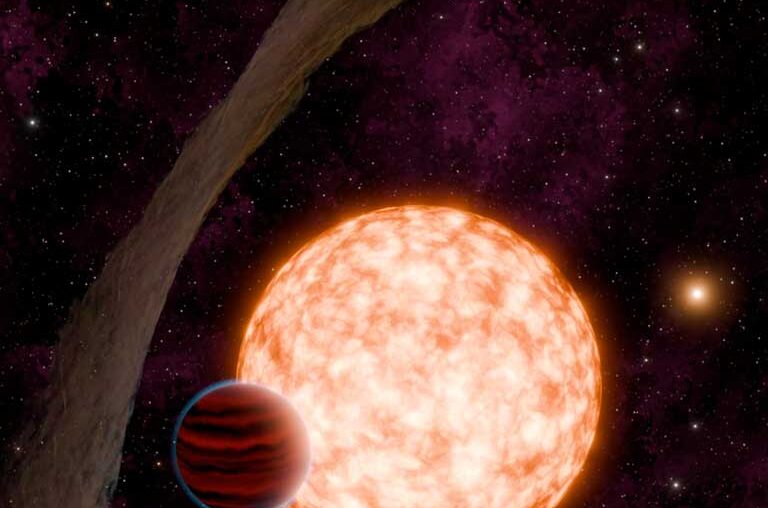Planets are thought to form within disks of dust and gas encircling newborn stars. But this cloudy environment tends to shield developing planets from view, preventing astronomers from observing their formation directly. Now, through a stroke of good luck, a still-forming planet has been detected early in its birth process, thanks to what may have been a chance encounter with a passing star that flipped part of the obscuring disk out of the way, exposing the baby planet.

Springer Nature
Previously, the youngest planet ever detected by the transit method, in which the dimming of a star’s light is measured as a planet crosses in front of it, was about 10 million years old — long enough for most of the dusty disk to have cleared. The new planet, cataloged as IRAS 04125+2902 b, is only about 3 million years old. Its host star still sports a large outer dust disk, but one that has been flipped to be almost perpendicular to a sparse inner disk and the orbit of the newfound planet.
Madyson Barber (University of North Carolina at Chapel Hill), lead author of a paper in the journal Nature this week announcing the discovery, tells Sky & Telescope, “It was originally thought that we wouldn’t be able to find planets this young.” Because stars and planets form from these collapsing disks of matter, and all of that material is expected to be in the same “pancake-like environment,” she says, “that disk would block our observations of the star,” so nothing as young as this would be detectable.
But it turned out that around this particular star, she says, “the outer disk for some reason warped out of the way and created this window into the star that allowed us to discover the planet.” Until now, she said, it was not clear that planets could even form this quickly after the birth of their host star. Earth, for example, took somewhere between 10 and 20 million years to form in the Sun’s natal disk.
The star itself, IRAS 04125+2902, is part of a widely separated binary system about 520 light-years away in Taurus. At first the team thought that the pull of the companion star might have been responsible for the warping of the disk. But they were able to rule that out, because the secondary star turned out to be orbiting the primary in the same plane as the newfound planet and the inner disk. Now, Barber says, “We think that maybe as the system was forming, there was some sort of flyby [of a star] that caused the disk to warp, but that’s not something we can really test.”
This discovery was made with NASA’s Transiting Exoplanet Survey Satellite, or TESS. Launched in 2018 and led by astronomers at MIT and the Center for Astrophysics | Harvard & Smithsonian, TESS has carried out a survey of the entire sky every two years since then. It has watched thousands of stars at once to detect the slight dimming of their light caused when a planet, in an orbit that happens to be edge-on as seen from Earth, passes in front of it. So far, TESS has been responsible for the discovery of at least 410 confirmed exoplanets.
Barber and her colleagues used a variety of methods to confirm that the object detected was indeed a planet, such as measuring the degree of dimming in different wavelengths of light. If the transiting object had been a star rather than a planet, there should have been variations in the dimming at different wavelengths, because the transiting star’s own light would be contributing to the mix, but no such variations were found. The planet orbits its star every 8.83 days. Because the name IRAS 04125+2902 b doesn’t exactly roll off the tongue, Barber has nicknamed the infant planet TIDYE-1b, a reference to the TESS Investigation – Demographics of Young Exoplanets (TI-DYE) survey, which has now racked up its first discovery.
“The team has done an incredible job of just being very careful” to rule out other possible interpretations of the data, says coauthor Sara Seager (MIT). “Whenever we see a planet and disk together, we get excited about that, because we’ve been trying to tie the two together for decades,” to learn more about the planet formation process. “It could be providing clues to a lot of outstanding problems.”
Barber says that there are a handful of other planets of similar age that have been found by other methods, “but those planets tend to be on wider orbits and more massive, so this is the first relatively small planet, close in, at this age, that we have found.”
The planet is especially interesting because it may fall into an intermediate category between Neptune-sized planets and Earth-sized rocky worlds. This category of sub-Neptunes or super-Earths is actually the most commonly found class of planets around other stars. Strangely, there are no planets of this size range in our solar system, so the details of their composition and formation remain relatively unknown.
The new planet is about 96 percent of Jupiter’s diameter but less than 30 percent of Jupiter’s mass. The team has concluded that it may be losing mass and could end up as a super-Earth, making it a particularly interesting object to study. It could potentially be a target for observations by the James Webb Space Telescope, which might provide spectroscopic data to reveal the planet’s composition and also help constrain the mass more precisely.
As a followup, Barber says, “I’m also in the process of looking for more young systems, since we’re not sure if this system is truly unique because of its configuration, or if there’s possibly a whole population of systems like this.”

